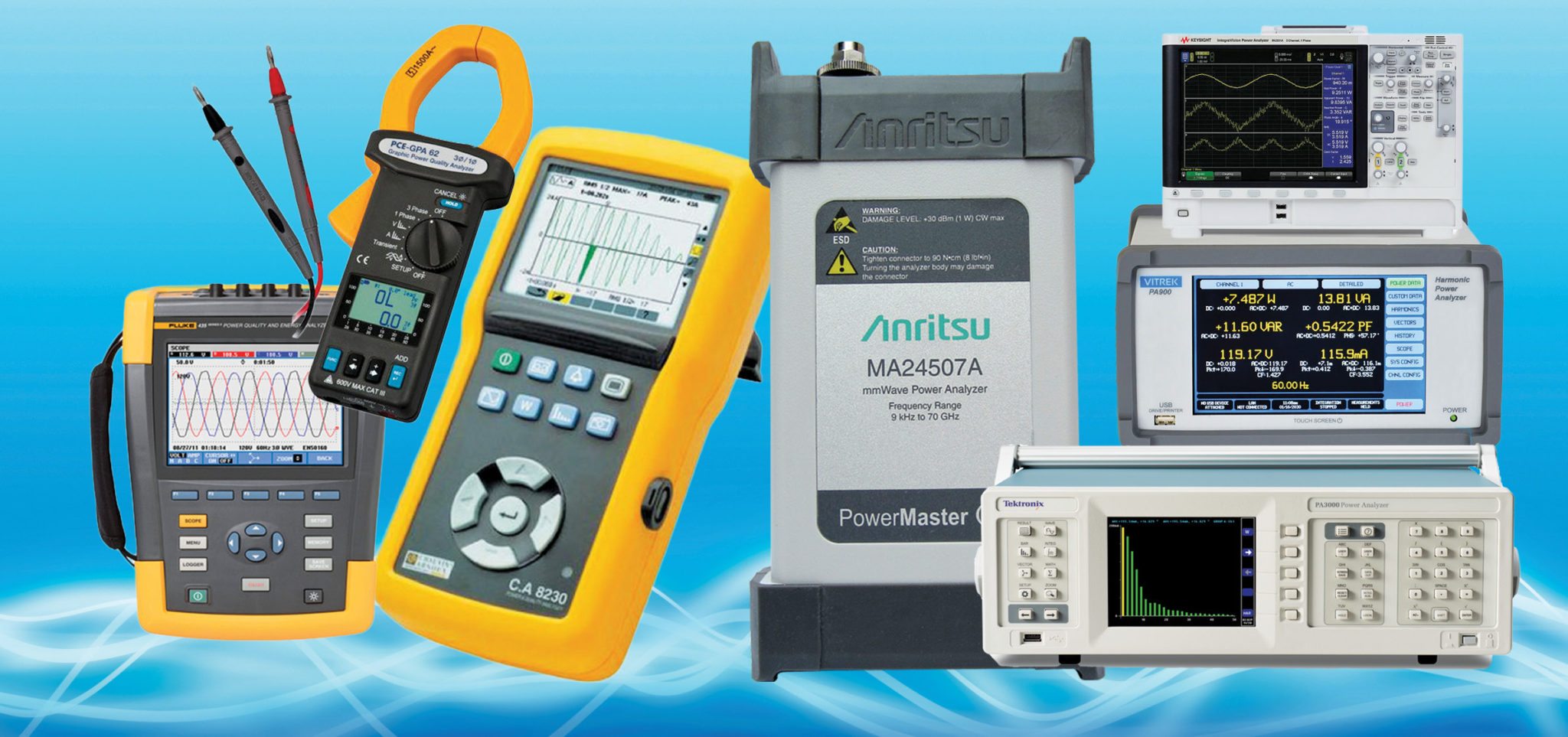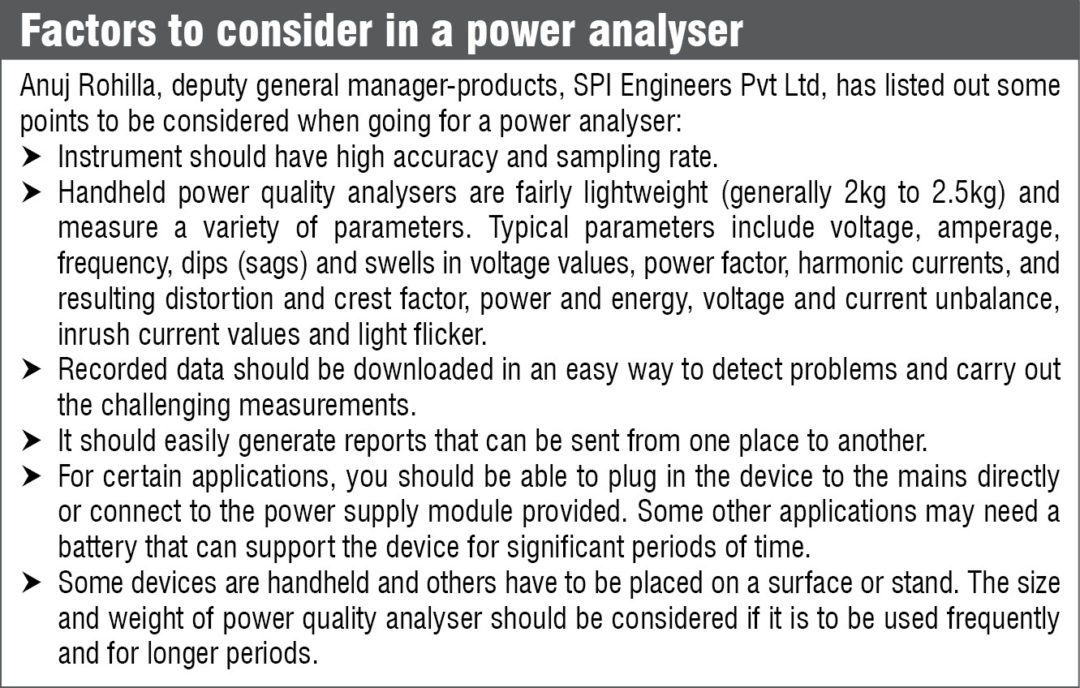The shift to handheld equipment has been going on for a long time. We now have handheld power supplies, multimeters and thermal imagers, among others. This is just one of the many changes test and measurement (T&M) equipment have undergone over the past few years.
Low power consumption is another. In the process of developing and testing such equipment, power analysers have been very useful. So in this article, we take a look at some of their latest features.

Custom logging is just one of the features
Traditional power meters were discrete products. “Those were designed to test basic power parameters at a nominal accuracy. Most of these were designed for testing active average power and did not have high enough sampling rates or bandwidth to handle modern non-linear power-converter signals,” says Nitin Nigam, application engineer, Tektronix.
Compared to those, recent power analysers offer much more. Today we have “custom logging features, waveform, harmonics and trend graphs to address all modern power analysis needs,” adds Nigam.
Power analysers offer insulated current input, measurement of harmonics, alternating and direct current (AC/DC), voltage, frequency, phase-rotation, and idle, apparent and effective power measurements. Basically you get almost all the power measurements of the device under test from a single piece of equipment, which is very convenient.
Flexibility of testing single- , two- and three-phase applications has also been an area of focus. You can perform testing in three-wire two-wattmeter method, four-wire three-wattmeter method or two-wire one-wattmeter method. Integrated software enhances application and flexibility of use, too.
These equipment can measure accurately even at low power factors such as 0.1 with up to 0.1 per cent basic accuracy. Usage of 16-bit microcontrollers and 24-bit analogue-to-digital converters allows accuracy and calculation of voltage, current, power, power factor, crest factor, form factor and frequency.

Apart from being used as energy-measuring devices, power analysers can also be used for network analysis and determination of harmonics and phase rotation. Incorporation of digital displays adds to the ease of use. PA900 from Vitrek delivers multichannel, wide-band performance and its coloured touchscreen user interface is easy to use.
Handling controls remotely: safety or ease
Electronic circuitry is improving day by day. New materials are under research to overcome attenuation and loss issues in electronic devices. Specs are getting better, resulting in handing over more and more control to the user. Madhukar Tripathi, senior manager – marketing and channel sales, Anritsu India Pvt Ltd, highlights some of these controls as, “user settings to control measurement speeds and noise floor.”
KM2200 from Kusam-Meco allows connection through local area network for remote control and measurement. Remote connections also have a safety angle.
Better safe than sorry. Safety with electrical equipment has always been an issue. Equipment often blow up, either due to shorting or overload, causing personal injury and equipment damage. The good news, however, is that these misfortunes are avoidable.
Some features are built in the system, like CAT rating requirements. Others are basic guidelines for safety. Tripathi says, “Connection of cable and antenna need special attention.” These should not be too loose or tightly connected. He adds, “After use, all cables and connectors must be kept safely, and caps should be used to cover connectors. This helps to save connectors and improve their life usage.”
KM2100 from Kusam-Meco features CAT III 1000V/CAT IV 600V for safety in addition to a protection shield in the multifunction harmonic and power analyser.
Equipment capture data, while the computer processes it
On an average, T&M equipment cost a lot. These have to be calibrated at regular intervals, as well. Proper maintenance, usage and precautions add to the confusion for an improperly-trained professional.
Certain steps have been taken in this regard recently, with a spread of over-the-air testing. Proper procedure still has to be followed, but testing gets easier. As a test engineer you can have your test results processed and ready for use.
Analysis of test data through a computer by logging it directly into the system makes testing easier. Universal series bus (USB), LAN, general-purpose interface bus (GP-IB), RS232C are some of the remote connectivity options available with the latest equipment.
No need of unnecessary measurements
Tripathi says, “Traditional power meters are broadband and have limited power ranges, so engineers and technicians are using spectrum analysers, which include many unneeded features, cost hundreds of thousands of dollars and take up half the test bench just to make simple, frequency based RF amplitude measurements.” A long-standing trend has been to make the equipment and readings as easy as possible.
Nigam adds, “It is important that the chosen equipment has a bandwidth and sampling rate that is at least ten times the highest frequency to be measured so that high-frequency signals are not filtered out.” This helps in high-frequency noise and harmonic content being taken into account while measuring root mean square values (RMS) and the actual heating effects of the signals.Powermaster from Anritsu is a portable, USB-powered millimeter-wave power analyser, which enables frequency based measurement of RF power from 9kHz to 70GHz with capabilities as low as -90dBm. All this is available in a USB-powered device slightly bigger than a smartphone.
PA3000 from Tektronix allows for a one mega-cycle per second sampling rate and 1MHz bandwidth, thus, helping high bandwidth to combat most power applications. There is also the option of injecting an external signal as a source of frequency where measured signals are extremely distorted and direct frequency detection is challenging.
Diverse application areas
Digital power analysers are used to measure voltage, current, wattage, apparent power, frequency and power factor of any electrical and electronic appliance, compact fluorescent lamps, light emitting diode bulbs, transformers, fans, air-conditioners, motors, auto parts and so on. High-accuracy, true-RMS, digital-readout and light-duty meters are used in general industrial maintenance, production, quality control and laboratories.
Anuj Rohilla, deputy general manager – products, SPI Engineers Pvt Ltd, points out “production and diagnostics in load industry as well as actuators and contractors” as another area of application of power analysers. He adds, “These serve as very efficient tools for increasing productivity and life expectancy of load devices and machine analysis with load impact.”
With increasing focus on electric vehicles, energy consumption efficiency of quick chargers is an important measurement and evaluation criteria that is being sorted out by power analysers.
3390 from Hioki displays voltage, current, active power, apparent power, power factor, frequency, loss, efficiency, distortion factor and voltage imbalance rate (when measuring three voltages and three currents), all at the same time.
Energy is one of the most precious resources. Design engineers are under constant pressure to increase efficiency and reduce power consumption down to the last milliwatt. Challenging programmes like light-emitting diode and high-intensity discharge lighting, solar panel energy output, efficiency testing on inverters and pulse-width modulation motor drive systems on electric vehicles, all require fast, precise and reliable power measurement.
GPA62 from PCE allows energy measurement in symmetrically-loaded three-phase systems. Power analysers PCE-PA 8000, PCE-360 and PCE-830 support professional power and energy measurements in single- and three-phase systems.
Benchtop versus handheld
With the shift to handheld equipment, benchtop equipment were supposed to take a serious hit. However, “Benchtop instrument will always remain the choice for lab (R&D) and production testing,” says Tripathi. Due to portability, handheld equipment can be taken out in the field and real-time tests can be performed more efficiently.
With the added over-the-air functionality and use of computers for processing data, the ease has been significantly increased. May be, sometime in the future, the only thing you would need to take out in the field would be probes.
Saurabh Durgapal is working as technology journalist at EFY





